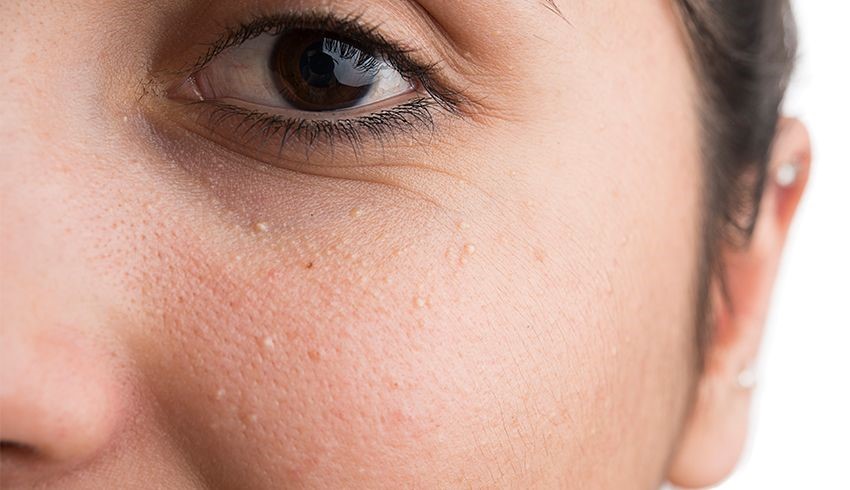
Milium, often known as milk spots, is a little white lump that appears around the eyes, forehead, and cheeks. Because these aggregates are frequently encountered in groups, they are referred to as milia. Milia are generally considered harmless, however, many people might prefer to have them eradicated. They can also go away without therapy, and they can also last longer than anticipated.
Keratin (a tough protein present in skin, hair, and nail cells becomes rendered immobile the epidermis, causing them. Milia can affect people of different ages, however, they are most frequent in infants. Milia can be treated using a variety of home treatments. While there is no one-size-fits-all solution for removing milia quickly, these therapies are generally low-risk.
Cause of Milia
Milia in adults is caused by a variety of reasons. They are most usually caused by dead skin accumulating and becoming caught in pores near the skin’s surface. It can turn into tiny cysts if it isn’t discharged spontaneously. Primary Milia is the name for this form of milia.
Secondary Milia is the other type of milia. Milia, both primary and secondary, have the same appearance but develop for quite distinct reasons. Secondary Milia occurs when the sweat ducts become clogged. Blisters, laser treatments, chemical peels, and herpes are all examples of skin trauma or infection that can cause this.
Sleep deprivation, nicotine, poor personal cleanliness, excessive use of oil-based skin care products, and long-term steroids use are all contributory factors.
Prevention
It’s critical to remove your makeup and cleanse your face at night before going to bed. Exfoliation is also effective in avoiding milia. Apply a light exfoliator to your entire faces, such as the eyes and eyelids, at least three times per week.
Retinol is also beneficial in the treatment and prevention of milia.
Restricting your consumption of cholesterol-rich food products, taking Vitamin D, limiting heavy oil-based beauty products or makeup products, and limiting sun exposure are all examples of lifestyle changes that can help prevent milia.
Milia are not poisonous, however, they are unattractive. You may easily and securely eliminate them by yourself if they aren’t on the eyelid or under the eye. Make careful to maintain your face clean to avoid milia in the future.
Home Treatments for milia
Honey
This miraculous substance is a natural humectant that helps your skin retain moisture. Apply raw honey to your skin and let it sit for 15 minutes before washing it away. This can be done daily until the bumps have vanished.
Add three teaspoons of oatmeal to raw honey and one tablespoon of granulated sugar to make a scrub. Once or twice a week, massage the scrub to your skin and leave it on for 15-20 minutes before rinsing it off carefully and gently wiping it off in circular motions. The scrub will unclog your clogged pores, and you will notice results almost immediately.
Apple cider vinegar
Apple cider vinegar is a miracle worker when it comes to a variety of issues. Its acidic characteristics account for its prominence in the treatment of milia. Apple cider vinegar’s acidic characteristics clear the skin’s clogged pores, causing the milia cysts to disappear. It also works to eliminate and reduce bacteria on the skin’s surface, which is a major cause of milia. Apply the vinegar to the afflicted region using sterilized and clean cotton. Before using apple cider vinegar, make sure there are no open sores on your skin because it might cause severe irritation.
Disinfect the region
It’s important to wash your face every day with a gentle, paraben-free soap. Any face wash that isn’t mild can deplete your skin’s natural oils, causing it to become unbalanced and unhealthy.
Rather than allowing your skin to air dry following washing, pat it dry. This will assist avoid chafing and drying your skin.
Retinoid Cream
Milia can be treated using retinoid creams, according to certain research. Retinoid is a type of vitamin A that should be used in moderation, only once a day. When using retinoid-containing products, you must always apply sunscreen because your epidermis is more susceptible to UV sunlight exposure.
Potatoes
Potatoes, which are high in starch, are one of the most effective and simple strategies to minimize milia. Potatoes’ antioxidants and abrasive characteristics aid to decrease excessive sebum production while also exfoliating dead skin cells.
Sugar Scrub
Sugar contains granules that are a great exfoliant. A sugar scrub aids in the unclogging of pores by removing dead skin cells from the top layer of skin, as well as removing milia.
Because the skin of the penis is weak and sensitive, rub it gently with the scrub. Excessive pressure might result in blisters and irritation.
Aloe Vera gel
The components in Aloe Vera Gel help to speed up the healing phase of infection. It contains anti-inflammatory qualities and is a great moisturizer. The gel relieves itching, redness, and irritation in the impacted parts of the body. It works by having a relaxing and calming influence on infection sensations.
Rose Water and Sandalwood
Sandalwood and rose water are both excellent skincare products. Make a smooth paste with enough rose water and two tablespoons of sandalwood powder. Apply it to your face and keep it on for a few minutes. Wash it off with water and do it again the next day.
Face sunscreen that is not too heavy
To safeguard the outer layer of the skin from UV rays, you may already be applying sunscreen daily basis. A reduction in skin irritation that produces milia can also be an advantage of using the correct sunscreen.
Search for a sunblock that is made exclusively for use on the face. Make sure the SPF is at least 30. Try using sunscreen with an SPF of 100 if your epidermis is sensitive to the sun.
Steam treatment
Your pores will open when you use steam. After cleansing, steaming your pores can help remove irritants even more effectively.
